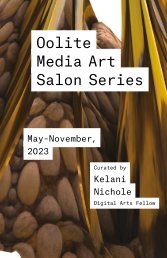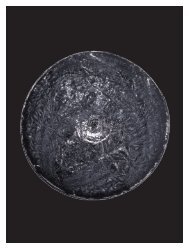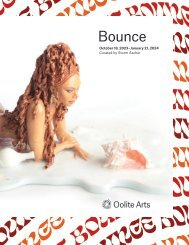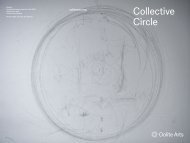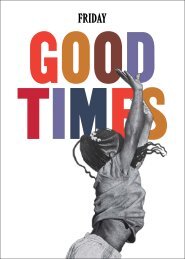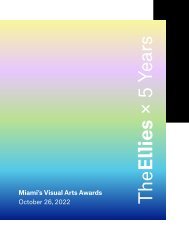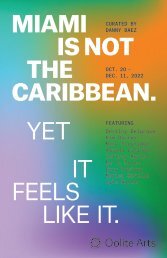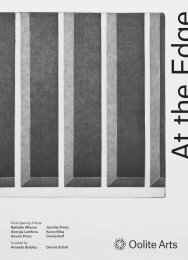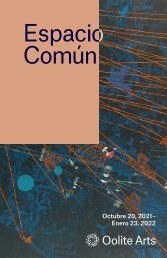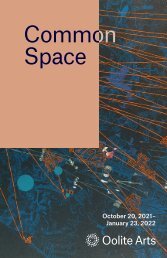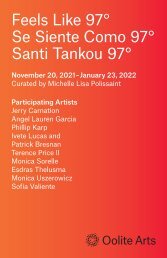Create successful ePaper yourself
Turn your PDF publications into a flip-book with our unique Google optimized e-Paper software.
at memory’s edge<br />
Curated by Luna Goldberg<br />
January 15 - February 5, 2022<br />
Fundación Pablo <strong>At</strong>chugarry<br />
5520 NE 4th Ave, Miami, FL 33137<br />
Artists:<br />
Ashley M. Freeby<br />
Efrat Hakimi<br />
Iris Helena<br />
Lihi Turjeman<br />
Catalog design:<br />
Philip Lique<br />
Editor:<br />
Laura Novoa<br />
ACKNOWLEDGMENTS<br />
<strong>At</strong> <strong>Memory's</strong> <strong>Edge</strong> is funded in part by the NWSA Alumni<br />
Foundation Inspiration Grant; Locust Projects’ WaveMaker<br />
Grants, which is part of the Andy Warhol Foundation for<br />
the Visual Arts ’ Regional Regranting Program; and The<br />
Ellies, Miami’s visual arts awards presented by Oolite Arts.<br />
This project is also made possible with support from the<br />
Carlo and Micol Schejola Foundation, The Fountainhead<br />
Residency, and The Fundación Pablo <strong>At</strong>chugarry.<br />
I am grateful to Ashley M. Freeby, Efrat Hakimi, Iris Helena,<br />
and Lihi Turjeman, who have been my partners in dreaming<br />
this exhibition to life and seeing it come to fruition. Thank<br />
you for your trust, friendship, and collaboration in this monumental<br />
project. I am also indebted to Piero <strong>At</strong>chugarry,<br />
Nataly Ballon, Amanda Bradley, Angie Gonzalez, Phil<br />
Lique, Betty McGhee, Lorie Mertes, Kathryn Mikesell,<br />
Laura Novoa, Monica Peña, Jaime Portas Vilaseca, my<br />
family, and countless others for their ongoing support.<br />
Luna Goldberg is a Miami-based curator, and currently serves<br />
as the education manager at the Jewish Museum of Florida–FIU<br />
and The Wolfsonian–FIU. Goldberg’s research focuses on global<br />
contemporary art and identity politics with an emphasis on<br />
Israeli art. She is the recipient of a WaveMaker Grant, Ellie Creator<br />
Award, and Fulbright Fellowship to Israel. Goldberg has curated<br />
exhibitions and programs in partnership with the Israeli Pavilion<br />
at the Venice Biennale, Detroit Art Week, and the Sullivan Galleries.<br />
She has held positions at the Museum at Eldridge Street, the<br />
Norton Museum of Art, and the Eric Carle Museum of Picture<br />
Book Art. Her writing has appeared in national and international<br />
publications including Kunstlicht: Journal for Art, Visual Culture<br />
& Architecture, Migration Processes and Artistic Practices in<br />
Wartime: From the Twentieth Century to the Present, and Sigalit<br />
Landau: Salt Years. Goldberg’s latest co-edited volume, Imagined<br />
Israel(s): Projections of the Jewish State in the Arts, is slated for<br />
publication in 2022.<br />
Designer, artist, and truth-teller, Ashley M. Freeby (b. 1986) uses<br />
natural materials, poetic language and minimalism to explore<br />
site, monuments, and data as a way of investigating the essence<br />
of memory and trauma. Unbound by medium, she allows her<br />
work to be centered by research, and truthful and uncensored<br />
narratives. Her recent project, (un)sterile soil, is a virtual installation<br />
of content where she highlights her work from 2016 to 2020,<br />
and collaborates with seven writers or artists to create a website<br />
over seven installments. (un)sterile soil, like much of Freeby’s<br />
work, is about the death and memory of Black bodies killed by<br />
law enforcement. She explores sites from above to below the<br />
surface to shift perspective and retain the memory for those lives lost.<br />
Freeby is a graduate of the School of the Art Institute of Chicago,<br />
currently resides in Allentown, Pennsylvania, and is the Communications<br />
Director and Head Designer for Ox-Bow School of<br />
Art & Artists’ Residency.<br />
Efrat Hakimi (b. 1982, Tel Aviv, Israel) is a multidisciplinary artist<br />
and educator based in Central New York and Tel Aviv. Hakimi<br />
works across technologies and crafts. In her works, she studies<br />
objects, language, and sites to unpack the narratives and forces<br />
that shape them. Hakimi is the recipient of the Lauren and Mitchell<br />
Presser Photography Award for a Young Israeli Artist from the Tel<br />
Aviv Museum of Art, 2020, and the Katz International Photography<br />
Award, 2018. She has exhibited at the Tel Aviv Museum of<br />
Art, Tel Aviv, Hyde Park Art Center, Chicago; Roots & Culture,<br />
Chicago; 6018 North, Chicago; Hayarkon 19 Gallery, Tel Aviv;<br />
Mana Contemporary, Chicago; 062 Gallery, Chicago; Rosenfeld<br />
Gallery, Tel Aviv. Hakimi received her MFA from the School of<br />
the Art Institute of Chicago (2019), studied Fine Art at HaMidrasha-<br />
Faculty of the Arts, Beit Berl (2016), and holds a BSc. from<br />
Ben-Gurion University, Be’er Sheva, Israel (2010).<br />
Iris Helena (b. 1987, João Pessoa – Paraiba, Brazil) is a Brasíliabased<br />
multidisciplinary artist with a degree in Visual Arts from<br />
the Federal University of Paraiba, and a Master’s in Contemporary<br />
Poetics from the University of Brasília, where she is currently<br />
completing a Doctorate in Visual Arts. Helena’s research is characterized<br />
by critical, philosophical, aesthetic, and poetic investigations<br />
of the urban landscape from a dialogic approach between<br />
the image of the city and the surfaces/supports chosen to materialize<br />
it. In her practice, precarious and ordinary materials are<br />
often removed from everyday consumption to enable the (re)construction<br />
of memory linked to risk, instability and, above all, the<br />
desire for erasure. Helena is also a member of the VAGA-MUNDO<br />
artistic research group: nomadic poetics linked to the University<br />
of Brasília. The Group conducts residencies and expeditions<br />
reflecting on geopoetics and landscape poetics. She is represented<br />
by Portas Vilaseca Gallery (Rio de Janeiro – Brazil).<br />
Lihi Turjeman (b. 1985, Tel Aviv, Israel) lives and works in Tel<br />
Aviv and Turin. She received her MFA from Bezalel Academy of<br />
Art in Jerusalem. In 2015, she was awarded the Israeli Ministry<br />
of Culture Award for Young Artists. Her large-scale painting<br />
installations are characterized by a monochromatic nature and<br />
revolve around space in its multiple forms and meanings. Her<br />
works emphasize an extreme duality, moving freely between an<br />
epic approach and a microscopic concentration on details that<br />
are drawn by ‘mapping’ and scratching the surface. Turjeman’s<br />
practice can be characterized as action painting, in which she<br />
performs physical actions on the surface of the canvas. Through<br />
smearing, rubbing, peeling, staining, and gluing, she hardens<br />
the fabric, while emphasizing its folds and textures. The canvas<br />
functions as a wall, a territory, or a map that is yet to be drawn.<br />
Turjeman is a former resident of Cité Internationale des Arts<br />
in Paris; Artport TLV; Fondazione Spinola Banna in Italy; Nars<br />
Foundation; and ISCP in Brooklyn, NY. In the past decade, she<br />
has exhibited at The Israel Museum in Jerusalem, the Tel Aviv<br />
Museum of Art, CCA TLV, Petach-Tikva Museum of Contemporary<br />
Art, and the Haifa Museum of Art, among others. Her works may be<br />
found in public and private collections in Israel, Europe, and the<br />
United States. Turjeman is represented by Sommer Contemporary<br />
Art, Tel Aviv/Zurich, and Ncontemporary, Milan/London.
Iris Helena, 21 Volumes, 2021
(un)sterile soil across<br />
the United States<br />
Ashley M. Freeby<br />
2020-ongoing<br />
The video was produced using Google Earth<br />
and takes the viewer to visit 88 murder plots<br />
across the Unites States in 15 minutes and 37<br />
seconds. Each Black body was shot and killed<br />
by the hands of a police officer.<br />
Akai Gurley<br />
Alexander Jamar “A.J.” Marion<br />
Allen Desdunes<br />
Alton Sterling<br />
Anesson Joseph<br />
Anthony Bartley<br />
Anthony Dwayne Harris<br />
Antonio Johnson<br />
Antwun Shumpert<br />
<strong>At</strong>atiana Jefferson<br />
Bettie Jones<br />
Botham Jean<br />
Breonna Taylor<br />
Cedrick Chatman<br />
Chad Robertson<br />
Chance David Baker<br />
Charles A. Baker Jr.<br />
Claude Reese Jr.<br />
Clinton Roebexar Allen<br />
Craig Demps<br />
Dainell Simmons<br />
Daryll Blair<br />
Dason Peters<br />
Deomain Hayman<br />
Dominique “Nonny” Silva<br />
Dominique Franklin Jr.<br />
Donovan Thomas<br />
Dontre Bennett<br />
Dylan Samuel-Peters<br />
Elijah Glay<br />
Eric Garner<br />
Ezell Ford<br />
Frank Smart<br />
Fred Bradford Jr.<br />
Freddie Gray<br />
George Floyd<br />
George Mann<br />
Gynnya McMillen<br />
Jason Akeem Lewis<br />
Jeffery B. Lilly Jr.<br />
Jeffrey Ragland<br />
Jerame Reid<br />
Jermaine McBean<br />
Jimmie Montel Sanders<br />
John Crawford III<br />
Jonathan A. Ferrell<br />
Jordan Baker<br />
Joshua Wayne Harvey<br />
JR Williams<br />
Julian Dawkins<br />
Kathryn Johnston<br />
Kayla Moore<br />
Kendall Alexander<br />
Kevin D. Garrett<br />
Lana Morris<br />
LaQuan McDonald<br />
Larry Eugene Jackson Jr.<br />
Marlon Horton<br />
Michael Brown<br />
Michael Lee Marshall<br />
Michael Sabbie<br />
Michell Cusseaux<br />
Montrell Moss<br />
Natasha McKenna<br />
Oscar Grant<br />
Philando Castile<br />
Quintine Barksdale<br />
Reginald Williams Jr.<br />
Ronnie Ledesma Jr.<br />
Roy Lee Richards<br />
Rumain Brisbon<br />
Russell Lydell Smith<br />
Sandra Bland<br />
Sean Bell<br />
Steven Isby<br />
Tamir E. Rice<br />
Terence Crutcher<br />
Tony McDade<br />
Tracy Clyde<br />
Trayvon Martin<br />
Tyrone West<br />
Walter Scott<br />
William Alfred Harvey III<br />
William Taylor<br />
Willie James Sams<br />
Willie James Williams<br />
Willie Lee Bingham Jr.<br />
Xavier Tyrell Johnson<br />
To learn more about this body of work, visit: www.unsterilesoil.online.
at<br />
memory's<br />
edge<br />
Monuments have simple desires:<br />
they want to live forever.<br />
They don’t want to die.<br />
They want to survive.<br />
They want to defeat death, and of course, this is<br />
a desire that gets projected within them, by their<br />
fabricators, perhaps, but usually by whatever the<br />
monument is to. 1<br />
With each monument that has been erected, we<br />
must ask whose history the structure embodies,<br />
and what histories are buried when a monument<br />
is constructed? 2<br />
Monuments and memorials have long served as<br />
placeholders reinforcing certain ways of telling<br />
history. In recent years, they have made headlines,<br />
as statues of former slave owners, police officers,<br />
and other power brokers have been toppled, dragged<br />
into rivers, vandalized, and removed from public<br />
space for their position as oppressive markers of<br />
white supremacy and racism. While certain states<br />
have passed laws prohibiting their removal, monuments<br />
around the nation have been destroyed,<br />
relocated to institutions and storage facilities, or<br />
replaced by new statues honoring previously unrecognized<br />
historical figures.<br />
Featuring works by Ashley M. Freeby, Efrat Hakimi,<br />
Iris Helena, and Lihi Turjeman, <strong>At</strong> Memory’s <strong>Edge</strong><br />
reflects on the construction of history, the form<br />
and function of monuments, and how, through<br />
questioning and challenging notions of memorialization,<br />
we address legacies of inequality and<br />
injustice. 3 The exhibited works investigate monuments<br />
as wounds of the past—structures that have<br />
manipulated the built environment and framed<br />
how we, as individuals and a society, navigate and<br />
negotiate public space and collective memory.<br />
Yet, monuments also question whose voices are<br />
represented and silenced against the backdrop of<br />
our cities and urban spaces, and which narratives<br />
are deemed worthy of being fixed in history. How,<br />
then, can we reimagine monuments and hold space<br />
for stories that we want to carry into the future?<br />
Among the many conventions of traditional monuments<br />
are their lasting materiality and imposing<br />
scale. Many of the memorials and statues that<br />
adorn city parks, squares, and avenues are made<br />
of granite, marble, and bronze—materials that<br />
withstand the extremes of weather. These monuments<br />
are thus able to “articulate their power<br />
from their seemingly permanent structures and<br />
endurance over time.”4 Their forms, often elevated<br />
on pedestals, serve the purpose of glorifying<br />
those portrayed, by way of posturing viewers. One<br />
cannot help but look up, when confronted by such<br />
monumental constructions. In her works Apontadores<br />
/ Finger Pointers and 21 volumes, Iris Helena<br />
challenges these conventions by cheekily reducing<br />
dozens of figurative monuments to the<br />
scale of post-it flags. The reproduced figures—<br />
mostly depicting white, Western men—exude<br />
confidence. Their haughty poses lead the gaze<br />
of viewers in all directions as their arms, swords,<br />
and fingers point to every corner of their frames.<br />
Against neon-colored backgrounds, these men<br />
(now only a few centimeters tall) become disposable<br />
and insignificant. They no longer have an arresting<br />
presence. Grouped together, rather, they form a<br />
taxonomy of monuments, reinforcing the absences<br />
among them—women and people of color. In<br />
21 volumes, 21 blank, white, hardcover books are<br />
dotted with these post-it flags. Emerging from<br />
their pages, miniature figures of monumental<br />
men bookmark each volume, representative of<br />
the 21 centuries of history to date. Helena’s works<br />
critique these ‘national heroes’, by exposing the<br />
power dynamics of history, and the deliberate decisions<br />
around what stories are told and by whom.<br />
Helena’s final work in the exhibition takes as its<br />
subject monuments to Christopher Columbus.5<br />
In 2020-2021, dozens of these monuments were<br />
removed both by protesters, and state and local<br />
authorities, as the United States was swept by a<br />
racial reckoning following the murder of George<br />
Floyd. Statues of Columbus across the country and<br />
internationally were beheaded, vandalized, pulled<br />
to the ground, set on fire, and thrown into bodies<br />
of water. In Erasing Columbus, Helena challenges<br />
monuments’ innate aspiration to last. Eight photographs<br />
of monuments to Columbus are suspended<br />
by wooden brackets. With exposure to natural light,<br />
the images, printed on thermal paper, disappear<br />
over time. Challenging the permanence of these<br />
structures and Columbus’ previously unquestioned<br />
position in history, the work is transformed over<br />
the course of the exhibition until all that remains<br />
are bare white surfaces.<br />
Similar to Helena in her consideration of a controversial<br />
historical figure, Efrat Hakimi’s works<br />
archive her sustained engagement with one particular<br />
monument—that of J. Marion Sims in New<br />
York’s Central Park. Long known as the ‘father of<br />
modern gynecology,’ Sims conducted gynecological<br />
experiments on enslaved Black women without<br />
their consent or anesthesia. 6 In fig. 1: Sims’<br />
speculum, Hakimi recreates the intrusive medical<br />
instrument, which would enable Sims, its inventor,<br />
and his successors to encounter and examine<br />
the inner workings of female genitalia. Utilized to<br />
perform standard pelvic exams, the probing object<br />
was developed as a result of Sims’ prolonged<br />
and unethical surgical experiments. Countering<br />
the male gaze which the speculum so forcefully<br />
embodies, in fig. 1: Sims’ speculum, Hakimi reconstructs<br />
Sims’ hand-drawn medical diagram in the<br />
form of a delicate relief, which self-effaces from<br />
afar. Contrary to the tool’s function in illuminating,<br />
the embossed instrument is embedded in<br />
black heavyweight paper, simulating that which<br />
is visibly absent from the narrative behind the<br />
speculum—the female body itself.<br />
Whereas this work reconsiders the dark history of<br />
a medical tool still used today, In Situ and 5th ave.<br />
and 103rd st. document the dethroning of Sims’<br />
monument in Central Park and the undoing of his<br />
legacy. In April 2018, Sims’ monument was taken<br />
down after nearly a decade of advocacy work by<br />
East Harlem activists calling for its removal. In<br />
Situ captures scenes of city workers methodically<br />
preparing for the statue’s extraction: metal barricades<br />
are installed around the site, and men climb<br />
onto the pedestal using crowbars and other tools<br />
to loosen the statue’s attachment from its base. On<br />
one screen, four men secure ratchet straps around<br />
Sims’ neck and person to lift the figure from its<br />
pedestal. Cloaked with a padded packing blanket,<br />
Sims’ statue is loaded onto a truck for relocation.<br />
All that remains is the pedestal, with a freshly-installed<br />
sign indicating that a new monument will<br />
be commissioned for the site. 7 Against this backdrop,<br />
we hear the voice of Michele Bogart layered<br />
into the ambient sounds of construction machinery<br />
and city traffic. In a three-minute statement at an<br />
NYC Public Design Commission meeting in April<br />
2018, Bogart appeals against the relocation of the<br />
monument to Green-Wood Cemetery, where Sims<br />
was buried. On a second screen, CBS News reporter<br />
Regina Wells stands in front of the monument<br />
with men at work, presenting a brief segment on<br />
the removal of Sims’ statue and the NYC Monument<br />
Commission’s review of controversial statues<br />
around the city. Juxtaposing these disparate positions,<br />
In Situ “interrogate[s] official perspectives, to<br />
1 W.J.T Mitchell, “Monuments, Monumentality, Monumentalization: W.J.T. Mitchell and Michael Taussig,” Monuments, Monumentality, Monumentalization: W.J.T. Mitchell and Michael Taussig<br />
(December 6, 2014), https://www.diaart.org/media/watch-listen/video-monuments-monumentality-monumentalization-w-j-t-mitchell-and-michael-taussig/media-type/video.<br />
2 danilo machado and Re'al Christian, “And the Body, Felix, Where Is It?,” Art Papers 44, no. 02 (2020): pp. 19-25, 21.<br />
3 The exhibition borrows its title from James E. Young’s 2002 book, <strong>At</strong> Memory’s <strong>Edge</strong>: After-Images of the Holocaust in Contemporary Art and Architecture. The book examines different strategies<br />
for memorialization enacted by artists, designers, and architects, which push back against traditional forms of monuments, and range from subtle interventions in public space to fleeting performative<br />
works and projections. See: James E. Young, <strong>At</strong> <strong>Memory's</strong> <strong>Edge</strong>: After-Images of the Holocaust in Contemporary Art and Architecture (New Haven, CT: Yale University Press, 2004).<br />
4 TK Smith, “Monumental Futures,” Art Papers 44, no. 02 (2020): pp. 26-31, 27.<br />
5 A controversial figure in history for his violent treatment of Indigenous peoples and his role in colonization, Columbus is recognized by hundreds of monuments and memorials erected in the 19th<br />
and 20th centuries across the Americas, the Caribbean, and Europe, among other places.<br />
6 Among these women, three have been identified by his writings—Anarcha Wescott, Betsey Harris, and Lucy Zimmerman. In September 2021, a monument to these women was erected in<br />
Montgomery, Alabama. See: Dennis Pillion, “Monument to ‘Mothers of Gynecology’ Unveiled in Montgomery,” Advance Local Media, September 27, 2021, https://www.al.com/news/2021/09/monument-to-mothers-of-gynecology-unveiled-in-montgomery.html.<br />
7 After much debate, in 2019, the New York City Department of Cultural Affairs commissioned Vinnie Bagwell to create a public monument to replace the Sims statue in Central Park. See: “Sculpture<br />
by Vinnie Bagwell to Replace Controversial Public Monument in New York's Central Park,” The online edition of Artforum International Magazine (Artforum, October 10, 2019), https://www.<br />
artforum.com/news/sculpture-by-vinnie-bagwell-to-replace-controversial-public-monument-in-new-york-s-central-park-81002.
consider empathy or the lack thereof in accepted<br />
narratives and to put pressure on the compartmentalization<br />
tactics of authority.” 8 Taken two<br />
years after the statue’s removal, 5th ave. and 103rd<br />
st. captures what remains of the site—its pedestal<br />
silhouetted by sheets of wood and adorned with<br />
an informational sign authored by NYC Parks.<br />
While Hakimi’s work addresses one monument<br />
over an extended period of time, Lihi Turjeman’s<br />
installation Tracing Shadows (Negative Space)<br />
considers the form of equestrian statues. Created<br />
while at The Fountainhead Residency in September<br />
2021, Turjeman’s work features the silhouette<br />
of an archetypal equestrian statue molded from<br />
research around these prevalent monuments to<br />
military men. Over the duration of her residency,<br />
the 1890 statue of Robert E. Lee on horseback<br />
in Richmond, Virginia was removed following an<br />
order by Governor Ralph Northam in 2020, and a<br />
ruling by the Supreme Court of Virginia in 2021. 9<br />
While equestrian statues reinforce heroic narratives<br />
from times past, they have also symbolically<br />
elevated members of royalty or military commanders<br />
to an otherworldly status; their scales often<br />
exaggerated to create a spectacle and force viewers<br />
to gaze upward in admiration. Such was the case<br />
of the Lee monument and the 40-foot pedestal<br />
on which it stood for over a century. 10 Preoccupied<br />
with archeology and the layers of history<br />
embedded within walls, floors, and other surfaces,<br />
in Tracing Shadows (Negative Space), Turjeman<br />
renders a monumental silhouette, which itself falls<br />
victim to the effects of time. The shadow-like figure<br />
and canvas are treated with charcoal, pigments,<br />
and other media to create the semblance of decay.<br />
Leaning against the gallery wall, the work, too,<br />
hints at the fate of many contested monuments<br />
today: suspended between public protest, official<br />
calls for their removal, and their execution. 11<br />
In 2020, amid the global protest movement resulting<br />
from the police killing of George Floyd, the<br />
site of the Robert E. Lee monument hovered<br />
in this space. It became a place of gathering for<br />
community members, organizers, and activists.<br />
Virginia-based lighting artists Dustin Klein and<br />
Alex Criqui cast projections on the monument,<br />
illuminating Black activists, thinkers, and victims<br />
of police brutality including Harriet Tubman, Rep.<br />
John Lewis, and Breonna Taylor, among others on<br />
the statue and its pedestal. 12 The granite plinth<br />
was also transformed by graffiti with hundreds<br />
of messages of protest, resilience, and hope. 13 It<br />
is unknown at this time what will become of the<br />
plinth and statue, but one can hope that the space<br />
they occupied will continue to function as one for<br />
community, mutual aid, healing, and resistance.<br />
For years, Ashley M. Freeby has dedicated her work<br />
to the memory of Black men, women, and children<br />
killed by law enforcement. Often rsearchbased,<br />
ephemeral, and labor-intensive, her practice<br />
meticulously documents the sites and stories<br />
of Black lives lost at the hands of police. Freeby’s<br />
works necessitate time, presence, and care, both<br />
to come to fruition, and to consume as a viewer.<br />
Her works are seductive. They draw you in and ask<br />
you to pause, acknowledge and grieve the unjust<br />
loss of life, and create space for healing. In (un)<br />
sterile soil across the United States, a dizzying<br />
frame zooms in and out of satellite imagery of<br />
the US on Google Earth. Stretching from coast<br />
to coast, the video moves in on marked locations<br />
named after victims of police brutality—each<br />
marker or pin denoting the murder plot where<br />
that individual was killed. 14 Over the course of 15<br />
minutes and 37 seconds, the video mechanically<br />
guides us to 88 sites, pausing briefly to allow viewers<br />
to absorb their surroundings: tree-lined streets,<br />
residential neighborhoods, sports stadiums. Were<br />
it not for the names of those lost, one would struggle<br />
to see the thread tying these seemingly ordinary<br />
locations together. Yet, as the frame retreats revealing<br />
constellations of pins and names, one cannot<br />
help but feel the weight and gravity of these losses,<br />
and the failures and brokenness of America’s criminal<br />
justice system.<br />
Few memorials exist to victims of police brutality.<br />
There are no plaques placed in the memory<br />
of the victims, and offerings made by the community<br />
are often temporary. With a handful of<br />
exceptions,few sites bear the trace of the trauma<br />
endured and held in the space. “...writing his dream<br />
inside a rectangle.” (the removal and replacement<br />
of 38.738360, -90.273701) investigates the site of<br />
Michael Brown’s murder in Ferguson, Missouri<br />
in 2014. Following his death, an eight by twenty<br />
foot plot of asphalt in the middle of Canfield Drive<br />
was removed, at the request of the Brown family—<br />
an effort “to prevent vehicles from driving over the<br />
location where their son had died at the hands of<br />
a police officer.” 15 The section of road was later replaced<br />
by the Canfield Green apartment complex<br />
management company, leaving a scar in the landscape.<br />
“...writing his dream inside a rectangle.” is<br />
a gravel floor piece installation occupying an eight<br />
by twenty foot rectangle. Simulating asphalt, the<br />
work is produced through the laborious act of<br />
hand painting hundreds of pounds of gravel and<br />
molding it to embody the site of loss. 16 An intervention<br />
in the gallery space, the work becomes an ephemeral,<br />
morphing, and discursive memorial. It is as much<br />
a piece honoring the life of Michael Brown as<br />
that of the countless other victims of police brutality.<br />
Upon disassembling the work, it too transforms,<br />
leaving behind the impression of its material<br />
weight—imprints of wet painted gravel which<br />
Freeby subtly incorporates into other works.<br />
A record of a record, a remnant.<br />
to <strong>At</strong>atiana Koquice Jefferson is another large scale<br />
work subverting the conventions of traditional memorials<br />
from Freeby’s ‘fertile grounds: flow down/<br />
up/onward’ quilt series. Made for <strong>At</strong>atiana Koquice<br />
Jefferson, the piece takes the form of an abstract<br />
quilt in memory of Jefferson’s life. 17 On the right-hand<br />
side of the piece, 28 prong-like adornments mark<br />
each year of her life. To its left, an open flap reveals<br />
the impression of gravel from “...writing his dream<br />
inside a rectangle.”, while the flap itself—an open<br />
portal hanging lower than the quilt’s bottom edge—<br />
is patterned by a vibrant cloudy blue sky. Outside<br />
the portal, other futuristic elements and fabrics,<br />
reminiscent of the galaxy, warm sun, and water fill<br />
a black backdrop. When facing the work, one is confronted<br />
by its scale in relation to the body, a narrow<br />
portal containing the space between earth and the<br />
heavens, the entirety of a life lost, an open grave.<br />
Historically, quilts were made to provide warmth<br />
and protection, decorate homes, express political<br />
views, and remember a loved one. No matter the<br />
pattern, their creation is a labor of love, which involves<br />
countless hours of selecting fabric, cutting<br />
pieces to scale, assembling, sewing, stitching and<br />
binding the patchwork. Through this cathartic act<br />
of remembrance, Freeby gives a piece of herself to<br />
the victims, while creating a comforting space for<br />
others to process grief.<br />
The artists in <strong>At</strong> Memory’s <strong>Edge</strong> set the groundwork<br />
for a new type of monument; one that is soft<br />
and malleable, agile and ephemeral. They present<br />
alternatives to permanence and interventions into<br />
history prompting us to both confront our past,<br />
turn the gaze inwards to reflect on the present, and<br />
consider what will mark our future. In this moment<br />
of (inter)national reckoning with monuments and<br />
public commemoration, the exhibition invites<br />
viewers to take a closer look at fixtures in their<br />
own communities and how we respond, recover,<br />
reimagine, and redress who and what our society<br />
memorializes.<br />
Luna Goldberg, Curator<br />
8 Efrat Hakimi, SAIC MFA Show 2019 (School of the Art Institute of Chicago, 2019), https://sites.saic.edu/mfa2019/artist/efrat-hakimi/.<br />
9 Over 60 feet tall, the monument honored Confederate Civil War General Robert E. Lee, a racist icon in American history. To learn more about Lee and his legacy, see: Russell Contreras, “How<br />
Robert E. Lee Went from Hero to Racist Icon,” Chicago Tribune, August 13, 2017.<br />
10 Following its removal Governor Northam stated: “After 133 years, the statue of Robert E. Lee has finally come down—the last Confederate statue on Monument Avenue, and the largest in the South.<br />
The public monuments reflect the story we choose to tell about who we are as a people. It is time to display history as history, and use the public memorials to honor the full and inclusive truth of who<br />
we are today and in the future.” See: Ralph S. Northam, “Governor Northam Statement on Removal of Lee Monument,” Virginia.gov, September 8, 2021, https://www.governor.virginia.gov/newsroom/<br />
all-releases/2021/september/headline-908938-en.html.<br />
11 While Turjeman’s Tracing Shadows (Negative Space) stages the dethronement of a monument, a sister piece, A Matter of Perspective, lies in Milan, Italy. There, the equestrian statue is represented<br />
from above, the three-dimensional monument turned into a floor piece. In both of Turjeman’s works, the act of flattening such monuments serves two functions; that of undoing the heroic myths<br />
associated with these memorialized men, and of marking their trace and histories by compressing their mass down to two-dimensional works. By shifting the perspective through which we view such<br />
monuments, Turjeman simultaneously seeks to disrupt the gaze enacted by their scale and render their histories touchable again.<br />
12 See: Natalie Colarossi, “Photos Show How the Robert E. Lee Statue in Virginia Has Been Reclaimed to Support the Black Lives Matter Movement,” Insider (Insider, July 21, 2020), https://www.<br />
insider.com/robert-e-lee-statue-repurposed-black-lives-matter-images-2020-7#the-face-of-civil-rights-leader-dr-martin-luther-king-jr-was-seen-on-the-monument-on-june-23-with-a-message-tosupport-a-bail-fund-above-it-7.<br />
13 Gregory S. Schneider, “Protesters Transformed Richmond's Robert E. Lee Memorial. Now They Mourn the Loss of Their Most Powerful Icon of Resistance.,” The Washington Post (WP Company,<br />
December 11, 2021), https://www.washingtonpost.com/dc-md-va/2021/12/11/richmond-lee-statue-pedestal-dismantled/.<br />
14 To learn more about this body of work, visit www.unsterilesoil.online.<br />
15 Ashley M. Freeby, “INSTALLATION INSTRUCTIONS ‘...writing his dream inside a rectangle.’ (the Removal and Replacement of 38.738360, -90.273701), 2021, 5.<br />
16 There have been three iterations of this work to date, each installed by different preparators. When producing this installation, Freeby offers an instruction manual for the piece, complete with<br />
background information on the work, materials, and instructions.<br />
17 <strong>At</strong>atiana Koquice Jefferson was shot to death in her home in Fort Worth, Texas, by a white police officer in October 2019. The officer was indicted by a grand jury on a murder charge in December<br />
2019, and the trial is set to begin in January 2022.
The Robert E. Lee monument with projections by Dustin Klein and<br />
Alex Criqui July 24, 2020. (Brian Palmer/Reveal)<br />
(next page)<br />
Ashley M. Freeby, ‘fertile grounds: flow down/up/onward’ quilt series<br />
to <strong>At</strong>atiana Koquice Jefferson, 2021
WHAT’S<br />
HAPPENING<br />
HERE?<br />
Who were Dr. J. Marion<br />
Sims, Anarcha, Betsy, and<br />
Lucy?<br />
Dr. J. Marion Sims (1813-1883) was known as<br />
the “father of modern gynecology.” He<br />
developed the treatment for vesicovaginal<br />
fistula, a painful condition which results<br />
from difficult childbirths.<br />
From 1934 to 2018 this was the site of a statue<br />
of Dr. James Marion Sims. Acknowledging a<br />
decade of protest by, social justice and health<br />
care advocates, community boards, elected<br />
officials, and community residents, the<br />
sculpture was removed in 2018. It is being<br />
replaced by a new permanent, public artwork.<br />
However, Sims’ discoveries are inseparable<br />
from the legacy of American slavery. Sims<br />
developed his fistula treatment by experimenting<br />
on enslaved Black women, three of<br />
whom he identified as Anarcha, Betsey, and<br />
Lucy. Enslaved people were denied rights,<br />
and were effectively unable to freely decide<br />
whether to participate in the experiments.<br />
Several patients underwent multiple surgeries,<br />
without the use of the then-new science<br />
of anesthesia, suffering horrific pain.<br />
Sims won fame through his discoveries, and<br />
was elected president of the American Medical<br />
Association in 1878. An effort to create<br />
a statue in his honor earned contributions<br />
from nearly 1000 medical professionals. The<br />
monument was dedicated in Bryant Park in<br />
1892, and moved to Fifth Avenue and 103rd<br />
Street across from the Academy of Medicine<br />
in 1934.<br />
Why Was the Statue Removed?<br />
In 1970s, scholars began to question the ethics<br />
of Sims’ methods and his exploitation of<br />
enslaved people. Over the past decade, East<br />
Harlem Preservation galvanized community<br />
action in a sustained effort to remove the<br />
statue. In 2018, noting broad popular opposition<br />
to the monument and its celebration of<br />
an individual who gained fame at the cost of<br />
great human suffering, the Mayoral Advisory<br />
Commission on City Art, Monuments and Markers<br />
called for the monument to be dismantled.<br />
Mayor de Blasio ordered its removal in<br />
April 2018.<br />
What Will Happen Now?<br />
Following the removal of the statue in spring<br />
2019, the City of New York and the Committee<br />
to Empower Voices for Healing and<br />
Equity—a community coalition established<br />
following Sims’ removal to represent local<br />
stakeholders’ voices—convened community<br />
discussions regarding the future of this site.<br />
The NYC Department of Cultural Affairs has<br />
allocated up to $1 million to commission a<br />
new artwork that addresses this monument’s<br />
history, helps move beyond Sims’ legacy, and<br />
affirms the rights of women and people of<br />
color, This piece will be installed by 2021.
Efrat Hakimi, In Situ, 2019




